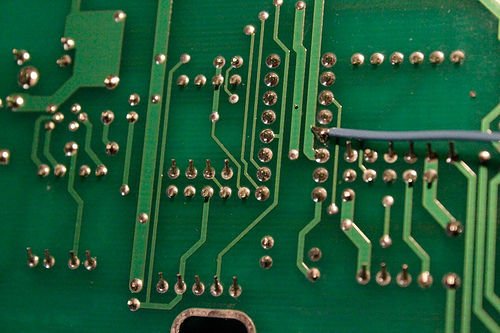I’m going to go through my process of hacking a Moog Etherwave Theremin. I created a new acrylic top, partially sanded to be translucent in certain areas, and created my own circuit around an ATMega168 Arduino Bootloaded microcontroller which is stealing a control voltage from the theremin’s board and is driving 2 RGB LEDs which react to your playing.
In this project I embed what I call a hackduino which is an Arduino-compatible circuit, in this case built out by hand on perfboard. I have made an instructable specifically about building one of these yourself, which you can read here.
 Step 1: Build out the microcontroller circuit
Step 1: Build out the microcontroller circuit
I will be attaching the Arduino code to upload to your chip
I have built mine out on perfboard from radioshack. Reasons why I do not just use an Arduino board: This is cheap, and completely permanent. This entire circuit cost about $7 and is much smaller than an entire Arduino. I can permanently add components as I need to. I feel a sense of hacker legitimacy when I don’t spend $35 on the bulky blue board.
3. LEDs…. [next step]
Step 2: LEDs!
Step 3: Theremin hack!
To get control voltages from the theremin itself, we are going to tap into one of OpAmp pins. I have had great success with soldering to pin 5 of the LM13700n chip on the board. However, this affords us access to just the amplitude (volume) antenna. I will find how to access the frequency antenna (pitch) and add that to this instructable when I do.
To get solder to this pin, remove the board from the theremin and flip it over. Attached is a picture of exactly what pin to solder to. Run the wire under the board toward the left side.
The next step in the hack is to attach female header pins to the row of breakouts located near the top left corner of the board when you are looking at it face on, right-side up (see images). The female headers will let us prototype easily.
Step 4: Get that board and LEDs in there!
The other nice trick I like to do is use styrofoam spheres to diffuse the LEDs. They can get quite bright, and the balls create a nice large object.
I used needle nose pliers to create a hole in each ball. Then just plopped the balls on top of each LED! So simple, cheap, and effective! yay efficiency!
 Step 5: Acrylic top time!
Step 5: Acrylic top time!
I used 1/4″ clear plexi for my top. Please post up any other materials you might find interesting/try out!
You will need approximately 2′ x 1′ piece of plexi, and using the Adobe Illustrator file I have attached, you shouldn’t have any problem at all. Laser the attached file (we have an Epilog 13 watt, I believe), and you’ll have a sweet top ready to go.
I decided I wanted both sides to be translucent, not clear (where the LEDs are). I drew a line at both sides, and with an exacto cut the paper along this line. I then take the paper off, and with a fine grit sandpaper (emory paper) go at the inside of the acrylic.
For more detail: Augment a Moog Etherwave Theremin


